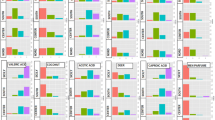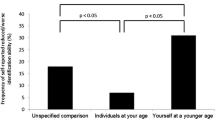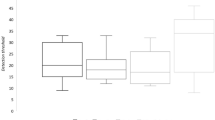Abstract
Objectives
The chemical sensitivity scale for sensory hyperreactivity (CSS-SHR) is used to quantify affective reactions to and behavioral disruptions by odorous/pungent substances in the environment and has documented good metric properties. However, normative data have not been available. The main objective of the present study was therefore to establish normative data for reference by means of a large-scale population-based study.
Materials and methods
From a random sample of 8,520 reachable inhabitants in the county of Västerbotten in Sweden, aged 18–79 years, stratified for age and gender, 3,406 individuals agreed to participate.
Results
The results show fairly high internal consistency (Cronbach’s α = 0.78–0.83) of the CSS-SHR and that it generates scores with approximately normal distributions (skewness: 0.045–0.454; kurtosis: −0.314 to 0.230), irrespective of age group and gender. Mean scores, standard deviations, confidence intervals, and proportions of individuals who met the diagnostic cutoff score for the CSS-SHR were obtained for reference of normality.
Conclusions
CSS-SHR can be recommended for quantification of affective reactions to and behavioral disruptions by odorous/pungent environmental substances, and with the advantage of comparing scores with normality.
Similar content being viewed by others
References
Andersson MJE, Andersson L, Bende M, Millqvist E, Nordin S (2009a) The idiopathic environmental intolerance symptom inventory: development, evaluation and application. J Occup Environ Med 51:838–847
Andersson L, Bende M, Millqvist E, Nordin S (2009b) Attention bias and sensitization in chemical sensitivity. J Psychosom Res 66:407–416
Andersson L, Nordin S, Millqvist E, Bende M (2009c) On the relation between capsaicin sensitivity and responsiveness to CO2: detection sensitivity and event-related brain potentials. Int Arch Occup Environ Health 28:285–290
Bessac BF, Jordt SE (2008) Breathtaking TRP channels: TRPA1 and TRPV1 in airway chemosensation and reflex control. Physiol (Bethesda) 23:360–370
Doty RL, Cometto-Muniz JE (2003) Trigeminal chemosensation. In: Doty RL (ed) Handbook of olfaction and gustation. Informa Healthcare, New York, pp 1603–1634
International Programme on Chemical Safety (IPCS) (1996) Conclusions and recommendations of a workshop on multiple chemical sensitivities (MCS), Feb. 21–23 Berlin, Germany. Regul Toxicol Pharmacol 24(suppl):S188–S189
Johansson Å, Brämerson A, Millqvist E, Nordin S, Bende M (2005) Prevalence and risk factors for self-reported odour intolerance: the Skövde population-based study. Int Arch Occup Environ Health 78:559–564
Johansson Å, Millqvist E, Nordin S, Bende M (2006) Relationship between self-reported odor intolerance and sensitivity to inhaled capsaicin: proposed definition of airway sensory hyperreactivity and estimation of its prevalence. Chest 129:1623–1628
Kipen HM, Hallman W, Kelly-McNeil K, Fiedler N (1995) Measuring chemical sensitivity prevalence: a questionnaire for population studies. Am J Public Health 85:574–577
Larsson C, Mårtensson L (2009) Experiences of problems in individuals with hypersensitivity to odours and chemicals. J Clin Nurs 18:737–744
Liker R (1932) A technique for the measurement of attitudes. Arch Psychol 140:44–53
Millqvist E (2000) Cough provocation is an objective way to test sensory hyperreactivity in patients with asthma-like symptoms. Allergy 55:546–550
Millqvist E (2008) Mechanisms of increased airway sensitivity to occupational chemicals and odors. Curr Opin Allergy Clin Immunol 8:135–139
Millqvist E, Bende M, Löwhagen O (1998) Sensory hyperreactivity: a possible mechanism underlying cough and asthma-like symptoms. Allergy 53:1208–1212
Multiple chemical sensitivity: A 1999 consensus (1999). Arch Environ Health 54:147–149
Nordin S, Millqvist E, Löwhagen O, Bende M (2003) The chemical sensitivity scale: psychometric properties and comparison with the noise sensitivity scale. J Environ Psychol 23:357–365
Nordin S, Bende M, Millqvist E (2004a) Normative data of the chemical sensitivity scale. J Environ Psychol 24:399–403
Nordin S, Millqvist E, Löwhagen O, Bende M (2004b) A short chemical sensitivity scale for assessment of airway sensory hyperreactivity. Int Arch Occup Environ Health 77:249–254
Nordin S, Broman DA, Wulff M (2005) Environmental odor intolerance in pregnant women. Physiol Behav 84:175–179
Nordin S, Broman DA, Bringlöv E, Wulff M (2007) Intolerance to ambient odors at an early stage of pregnancy. Scand J Psychol 48:339–343
Proposition 2007/08:44. Vissa etikprövningsfrågor m.m. www.riksdagen.se/webbnav/index.aspx?nid=37&dok_id=GV0344
Söderholm A, Söderberg A, Nordin S (2011) The experience of living with sensory hyperreactivity: accessibility, financial security and social relationships. Health Care Women Int 32:686–707
Statistics Sweden (2011). www.scb.se/default_2154.aspx
Ternesten-Hasséus E, Löwhagen O, Millqvist E (2007) Quality of life and capsaicin sensitivity in patients with airway symptoms induced by chemicals and scents: a longitudinal study. Environ Health Perspect 115:425–429
Weinstein ND (1978) Individual differences in reactions to noise: a longitudinal study in a college dormitory. J Appl Psychol 63:458–466
Acknowledgments
This study was supported by grants from the Swedish Asthma and Allergy Association’s Research Fund, the European territorial cooperation program Botnia-Atlantica, Region Västerbotten (Sweden), and the Regional Council of Ostrobothnia (Finland). We gratefully acknowledge Annika Glader for supervising the TEMA project, of which this work was part.
Conflict of interest
The authors declare that they have no conflicts of interest.
Author information
Authors and Affiliations
Corresponding author
Rights and permissions
About this article
Cite this article
Nordin, S., Palmquist, E., Bende, M. et al. Normative data for the chemical sensitivity scale for sensory hyperreactivity: the Västerbotten environmental health study. Int Arch Occup Environ Health 86, 749–753 (2013). https://doi.org/10.1007/s00420-012-0812-2
Received:
Accepted:
Published:
Issue Date:
DOI: https://doi.org/10.1007/s00420-012-0812-2




